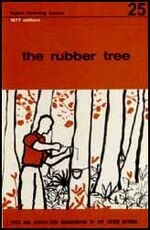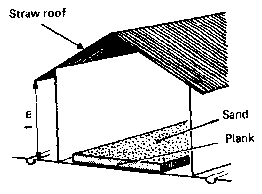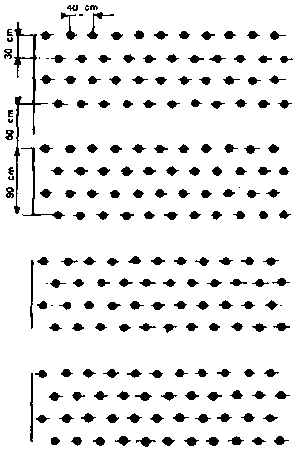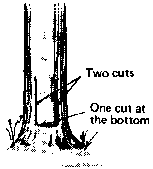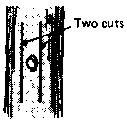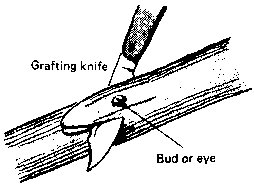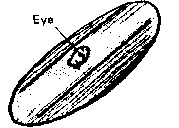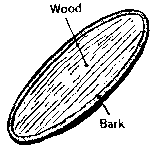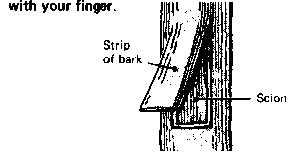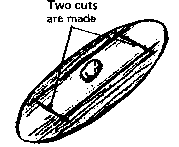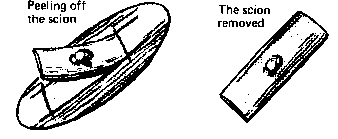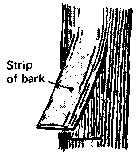It takes a long time to get good rubber tree seedlings to put in the plantation.
It takes two years to get seedlings for putting in the plantation.
To raise seedlings for the plantation, you must:
- make the seeds germinate in the germinator;
- put the germinated seeds in the nursery;
- look after the nursery;
- graft the young seedlings in the nursery.
Germinating seeds in the germinator[edit | edit source]
To do this, you have to:
- make the germinator;
- choose the seeds;
- put the seeds in the germinator.
A germinator is the place where you sow the seeds to make therm germinate.
To make a germinator you must choose ground that is quite flat, that has no vegetable refuse on it; you must choose a spot that can be easily watered.
Make beds 1 metre wide.
Each bed is edged with planks, so as to make a box.
Into each box put sand to a depth of 10 centimetres.
Cover the germinator with a roof made of straw.
The roof must be at least 1 metre above ground, so that you can get underneath it to put the seeds to germinate.
The roof
- Choosing the seeds
To get good seeds, it is best to ask for them at a seed selection centre.
The seeds must be put in the germinator as soon as they have been harvested for they very quickly become unable to germinate.
When you put the seeds in the germinator, you must look to see if each seed is shiny and bright. If is not, do not put it in, because it will not germinate.
- Putting the seeds in the germinator
Push the seed half way into the sand, with the rounded side of the seed uppermost.
Push the seed half way into the sand
Put the seeds close together, side by side, and water them.
To make a plantation of 1 hectare, with 625 trees, you must put 1 700 seeds to germinate. So you must have a germinator 1.7 metres long and 1 metre wide.
A week later the seed has germinated, and the rootlet is about 2 centimetres long.
This is the time to take the seeds out of the germinator and put them in the nursery.
Putting the germinated seeds in the nursery
The nursery is the place where you put the germinated seeds so that they will grow into young rubber trees.
- The soil of the nursery must be well prepared
Choose a spot that is easy to water.
Grub up all trees.
A few days before planting the germinated seeds remove all vegetable refuse.
The soil must be tilled by hand very deeply, to at least 60 centimetres, with a hoe.
Then the soil must be levelled and harrowed to break up clods.
This is how the nursery is made ready for the germinated seeds.
Putting the germinated seeds in the nursery[edit | edit source]
The germinated seeds are planted in rows. In each row leave 40 centimetres between seeds. Leave 30 centimetres between the rows. Plant the seedlings (germinated seeds) in alternate spacing, as shown in the drawing on page 9. Make four rows in each nursery bed. Leave 60 centimetres between the nursery beds. After every four beds, leave a space of 1.20 metres.
Thus 1 hectare will contain 58 000 seedlings.
To make a plantation of 1 hectare, you have to plant 1 500 germinated seeds; that means two nursery beds, each 70 metres long.
When transplanting the seedlings, press the soil well down round the tap- root and the rootless, without damaging them.
Water the seedlings as soon as you have transplanted them.
Plan of nursery[edit | edit source]
Plan of nursery
Looking after the nursery[edit | edit source]
You must hoe often to get rid of weeds, and to keep the soil moist.
In the dry season you must water rather often. But do not water in the middle of the day. Water in the morning or in the evening.
If the soil is not very fertile, you can give it fertilizer, as follows:
- The first time, 2 months after transplanting, give 150 kilogrammes of ammonium phosphate to each hectare and 75 kilogrammes of potassium chloride to each hectare. This means that for a bed of 70 square metres you need 1 kilogramme of ammonium phosphate and 0.5 kilogramme of potassium chloride.
- The second time, 5 months after transplanting, give the same amounts.
But you must get advice from technical officers, because different soils have different needs.
Ten months after transplanting to the nursery, take out the young plants that have not grown well.
When the young plants are between 12 and 15 months old, during the short rainy season, grafting must be done.
Grafting is a difficult job. You must pay great attention to it.
Grafting young plants[edit | edit source]
Grafting means putting into a young plant (the stock) a little piece of a branch (the scion) taken from a tree of good quality.
The young plant in the nursery is the stock. It will provide the roots of the plant which is to be put into the plantation.
You take a piece of a branch from a tree that gives plenty of latex this is called the scion. The scion will provide the stem of the plant that is to be put into the plantation.
To graft you use a grafting knife with a very sharp blade.
Grafting knife
To do the grafting, you have to:
- prepare the young plant from the nursery (the stock)
- take the scion from a tree of good quality;
- place the scion in the stock.
Afterwards look to see if the graft has succeeded.
- Preparing the stock
When the young plant in the nursery (the stock) is 3 or 3.5 centimetres thick, it can be grafted.
A few centimetres above the ground, make two cuts in the stock about 4 or 5 centimetres long and 2 centimetres apart. Then make one cut at the bottom to join the other two cuts at the lower end.
Preparing the stock
All these cuts are made in the bark only. You must not cut into the wood.
You will see, if you cut a stem right across, that
- outside is the bark;
- inside is the hard wood.
You cut a stem right across
The cuts must be made so that the bark can be peeled back.
Make the cuts on 20 plants, one after the other. You will see a white liquid flowing out. This is the latex.
- Taking the scion
Ask at a selection centre for rubber tree branches for grafting. These branches have about the same thickness as the stock. They are called grafting wood.
These branches for grafting have no leaves; the leaves have been taken off 10 days before cutting the branches. As soon as the selection centre has given you the grafting wood, the grafts must be done at once, during the next 24 hours.
In the first- year course we learned that on the stem there are buds below the leaves. If you look closely just below a leaf you will see that there is a bud.
This bud is called an eye.
Bud
To get a scion, take an eye with a little piece of the bark round it.
Take a branch of grafting wood in order to remove an eye from it. Round this eye make two cuts 5 or 6 centimetres long and 1 or 2 centimetres apart. You will see the latex flow out.
Make two cuts
Remove the eye by cutting into the wood of the branch with the grafting knife.
Remove the eye
Now you have a piece of grafting wood with an eye in the centre of it.
Eye
If you look at the back of this piece of wood, you will see that:
- in the middle there is wood;
- round the outside is bark.
- Putting the scion in the stock
Wood
With a rag, wipe off the latex that has flowed out of the stock.
Peel back gently the strip of bark cut when preparing the stock.
You must not touch the underside of this strip with your finger
You must not touch the underside
Take the piece removed from the grafting wood. Make two cuts, one on each side of the eye, so as to mark off the scion.
Make two cuts
Peel off the piece of bark with the eye. Do not take any wood and do not touch the underside of the scion.
Peeling off the scion
Now you have the scion by itself.
Next, put the scion under the strip of bark peeled back on the stock.
Do not touch the wood of the stock and the back of the scion.
Strip of bark
Put back the strip of bark over the scion and bind it to the trunk with a band 4 centimetres wide and 60 centimetres long. The graft is finished.
To plant 1 hectare, 1 400 plants must be grafted.
Three weeks after making the graft, take away the band and cut the strip of bark at the top of the vertical cuts. The graft has been successful if the scion is well joined to the stock, and if the graft is green when you scratch it a little. There should be at least 85% of successes.
The young plants are now left in the nursery until the next rainy season. Then the grafted plants will be put into final position in the plantation.
